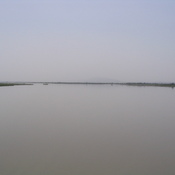Er zijn nog geen Nederlandstalige annotaties. Hier volgen annotaties in het Engels.
Bucephala was a Hellenistic city in the Punjab which was founded by Alexander the Great, and is thought to have been located at the site of the modern city of Jhelum. The city was known as Bucephala, Bucephalia, Alexandria Bucephalus, Alexandria Bucephala and Alexandria Bucephalous, or, in Greek, Alexandreia Boukefala.
During Alexander the Great's conquest of the Punjab in 326 BCE, the native king Porus of the Pauravas organised a last stand against the Macedonian conqueror at a ford of the river Hydaspes, known in Sanskrit as Vitasta and in modern times as the river Jhelum. Against the Indian king's expectations, Alexander managed to cross the river, which was very wide because of the yearly melting water from the Himalayas, and Porus was defeated. However, during the battle, Alexander's beloved horse Boukefalos had died. Alexander honoured his horse by founding a city bearing the name of his former steed on the western side of the river Hydaspes, where the battle against Porus had taken place. On the opposite side of the ford, the sister city of Nikaia, meaning ''victory'', was founded.
Alexander settled the new city, which was to house a permanent garrison, with Greek and Iranian veterans, and with local natives. He had large dockyards built, which implies that he intended for the city to become a major centre of commerce. The city was located on the Great Trunk Road, the great Indian subcontinental road, which crossed the Hydaspes at the ford where the battle had taken place; from here, one could travel westward to Gandhara and the Persian and Bactrian lands which lie beyond, and eastward to the large city of Pataliputra, now known as Patna, and onward to the Ganges delta.
The 1st century CE Periplus of the Erythraean Sea mentions that ''the country inland of Barigaza is inhabited by numerous tribes, such as the Arattii, the Arachosii, the Gandaraei and the people of Poclais, in which is Bucephalus Alexandria". The late classical Metz Epitome also mentions the city as ''a town now called Bucephala'', and an Alexandria Bucephalos is shown on the Late Roman Peutinger Map; these mentions could imply either that the city still played a significant role in Late Antiquity or that the authors of these works had simply copied the name from older works.
Though full consensus has not yet been achieved, some scholars think that the city was located at the site of the modern city of Jhelum in Pakistan.
Bucephala was a Hellenistic city in the Punjab which was founded by Alexander the Great, and is thought to have been located at the site of the modern city of Jhelum. The city was known as Bucephala, Bucephalia, Alexandria Bucephalus, Alexandria Bucephala and Alexandria Bucephalous, or, in Greek, Alexandreia Boukefala.
During Alexander the Great's conquest of the Punjab in 326 BCE, the native king Porus of the Pauravas organised a last stand against the Macedonian conqueror at a ford of the river Hydaspes, known in Sanskrit as Vitasta and in modern times as the river Jhelum. Against the Indian king's expectations, Alexander managed to cross the river, which was very wide because of the yearly melting water from the Himalayas, and Porus was defeated. However, during the battle, Alexander's beloved horse Boukefalos had died. Alexander honoured his horse by founding a city bearing the name of his former steed on the western side of the river Hydaspes, where the battle against Porus had taken place. On the opposite side of the ford, the sister city of Nikaia, meaning ''victory'', was founded.
Alexander settled the new city, which was to house a permanent garrison, with Greek and Iranian veterans, and with local natives. He had large dockyards built, which implies that he intended for the city to become a major centre of commerce. The city was located on the Great Trunk Road, the great Indian subcontinental road, which crossed the Hydaspes at the ford where the battle had taken place; from here, one could travel westward to Gandhara and the Persian and Bactrian lands which lie beyond, and eastward to the large city of Pataliputra, now known as Patna, and onward to the Ganges delta.
The 1st century CE Periplus of the Erythraean Sea mentions that ''the country inland of Barigaza is inhabited by numerous tribes, such as the Arattii, the Arachosii, the Gandaraei and the people of Poclais, in which is Bucephalus Alexandria". The late classical Metz Epitome also mentions the city as ''a town now called Bucephala'', and an Alexandria Bucephalos is shown on the Late Roman Peutinger Map; these mentions could imply either that the city still played a significant role in Late Antiquity or that the authors of these works had simply copied the name from older works.
Though full consensus has not yet been achieved, some scholars think that the city was located at the site of the modern city of Jhelum in Pakistan.



